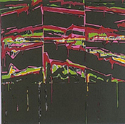Sample : Ethonology/History, Fine Arts/Decorative Arts, Science/Technology
Jacques Hurtubise, © SODART; TOUTE REPRODUCTION INTERDITE / ALL REPRODUCTIONS PROHIBITED
| Field Name |
Value |
|
|
| Institution |
Leonard & Bina Ellen Art Gallery |
| Accession Number |
998.10 |
| Discipline |
Fine Arts |
| Object Category |
Fine Arts |
| Object Sub-category |
Painting |
| Object Name |
painting |
| Object Type |
polyptych |
| Quantity |
1 |
| Component Part Names |
panel (9) |
| Number of Components |
9 |
| Artist/Maker |
Hurtubise, Jacques |
| Title |
Rosa Rose |
| End Date |
1974 |
| Period |
3rd quarter of the 20th century |
| Unit Linear |
cm |
| Height |
183 |
| Width |
183 |
| Medium |
acrylic |
| Support |
canvas |
| Signature |
Hurtubise 74 |
| Inscription |
© |
| Subject/Image |
abstract |
| Description |
The work is an abstraction done on nine square canvases fixed together into one large, square polyptych. The three component
panels of the upper and middle rows carry angular, horizontally oriented, colored forms that are loosely grouped into three
jagged bands. The three panels of the bottommost row show vertical drips of color: green, yellow, white, and red. Red and
pink, set against a black ground, are the predominant colors of the work.
|
| Narrative |
Rosa Rose is a painting situated within a body of work begun in the early seventies wherein the artist began using small
square canvases locked together to form a grid-like construction. A departure from the serial geometric patterns of the late
sixties, these new works provided a means for the artist to explore a different constructive approach. Organizing his canvases
by restructuring individual units allowed the work to evolve in a more controlled and less random manner. By the end of the
decade Hurtubise's investigations of what has been described as the "controlled accidents" of paint led to greater exploration
of movement and gesture, anticipating the later rippled surfaces which have become prominent in our understanding of this
artist's oeuvre.
|
| Originating Continent |
North America |
| Originating Country |
Canada |
| Originating Province |
Quebec |
| Culture |
Canadian |
|




